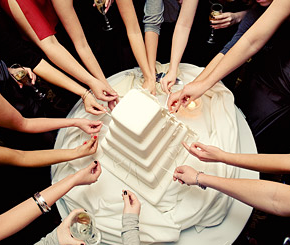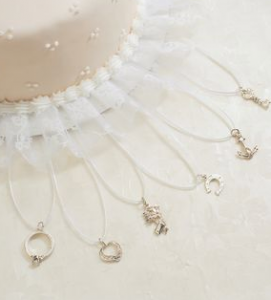Include a Topper!
-
Happy Birthday Banner
$9.00
Add Ons
Your cart is currently empty!

Down here in New Orleans we have an odd tendency to put inedible trinkets into our food. Not only do we put plastic babies in our king cakes as a way of celebrating Mardi Gras, but one of our most common wedding traditions includes hiding silver charms in wedding cakes as a form of divination. What am I talking about? Well that would be the cake pull, a tradition with a surprisingly tangled history.

Cake Pull Basics
A cake pull, sometimes also known as a ribbon pull, is a New Orleans wedding tradition not unlike the bouquet toss. The bride gathers a number of her single or eligible female friends around the wedding cake. Inserted into the wedding cake are various charms with ribbon tails. After a count of three each of the women pull a ribbon, exposing a charm. The charm is meant to signify the puller’s future.
There are eight classic charms historically used for ribbon pulls, each with its own meaning. The ring (which indicates the next to get married), the horseshoe or the four-leaf clover (signifying good luck), the telephone (offering good news), the anchor (encouraging hope), the heart (indicating impending love), the thimble or the button (revealing the old maid), and the penny (meaning poverty). While these are the charms used most often, a cake pull can have up to twenty different charms for the various single friends of the bride.
The charms are usually inserted into the bottom layer of the cake (after it is baked, but before it is frosted) and are often made of sterling silver so as to be a keepsake for the woman who pulled it. Many brides provide bracelets as gifts for the charm to be worn on.
Occasionally the cake pull takes place at the bridal shower or brunch, but most often it occurs during the wedding reception before the cake is cut. Being chosen to pull a ribbon demonstrates a closeness with the bride or groom and is an honor that extends beyond the bridal party alone. The cake pull is a secular tradition prevalent across all areas of New Orleans and unrelated to any particular religion or ethnicity.
A Tangled Ribbon of History
Most people feel it is safe to assume that ribbon pulling is originally a French tradition, like much else in New Orleans, but this assumption couldn’t be further from the truth. Ribbon or cake pulling was actually brought to America by our English speaking counterparts in the United Kingdom. Ribbon pulling has antecedents in English, Irish, and Scottish cultures that date back even as far as the 1600s.
In 17th century England it was a tradition for the bride to have charms sewed onto the skirt of her dress. These charms would later be pulled from the dress by the bridesmaids and kept as tokens of luck and friendship. It is believed that over the course of many decades, the trinkets were transferred from the dress to cakes, creating the Victorian tradition of baking a ring into a “bride’s pie”. The bride’s pie was the first example of a true wedding cake, and the woman to find the ring was said to be the next to get married.
Northern Ireland used a similar tradition to divine the futures of single women on Hallow’s Eve. The Irish baked talismans into dense fruit cakes called “bracks” or “barmbracks”. The talisman or token the woman revealed in her brack on Hallowe’en was meant to tell her future in the same way that cake pulls are meant to now. An example of this tradition can even be seen in James Joyce’s The Dubliners, where a token of clay morbidly comes to represent early death.
Scotland also has a long history of decorating wedding cakes with inedible ornaments, a tradition that has long been connected with the origin of cake pulls. So while ribbon pulling is decidedly not French, its history is a jumble of cultural traditions from England, Ireland, and Scotland that have developed, derived, and melded over time and were brought to New Orleans from British immigrants.
Big Easy Twist
The cake pull has been a tradition in New Orleans that dates back well over 75 years. It’s thought that Scottish baker, Henry C. “Mack” McKenzie (founder of McKenzie’s Bakery) was responsible for popularizing the cake pull in the New Orleans area in the early 1920s and throughout the twentieth century.
Today’s cake pulls often have a New Orleans spin, with charms that reflect local culture. In addition to the classic charms, it’s common now to find jesters, Mardi Gras masks, fleur-de-lis, pelicans, water meter covers, streetcars, and even oysters. The meanings of these charms vary, but contemporary brides tend to choose charms that can extend to more than just their single friends, including charms with meanings of happy homes and families, and good health.
While the charms are meant to be a surprise for the puller, it’s often rumored that the cake’s is “stacked” so to speak. The bride may choose certain charms for certain girls and arrange them conveniently around the cake, or designate them with different colored or shaped ribbons. It’s believe that the ring will always be the first ribbon to the right of the bride, reserved for the maid of honor to pull. So next time you’re at a New Orleans wedding, if you’re lucky enough to be chosen, try your luck with the ribbon closest to the bride.